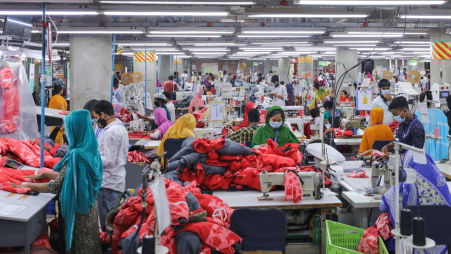In FY23, Bangladesh’s exports to the world market were more than $55 billion, where RMG’s share was $47 billion and non-RMG’s share was $8.5 billion.
Bangladesh has the potential to increase its export earnings to $22.5 billion from major non-RMG products to the European Union by enhancing its supply-side capacity, suggests a study.
Additionally, earnings from ready-made garment exports could rise up to $60 billion to the EU market through the diversification of garment items, according to the study of the Research and Policy Integration for Development Bangladesh (RAPID).

While presenting the findings at a programme titled “Exploring Export Diversification Opportunities in the European Union” at a city hotel on Monday, RAPID Chairman MA Razzaque said, “Bangladesh has a golden opportunity in the EU market if the country successfully diversifies its export baskets.”
In FY23, Bangladesh’s exports to the world market were more than $55 billion, where RMG’s share was $47 billion and non-RMG’s share was $8.5 billion.
These estimations are based on the current supply-side capacity, demand conditions, and market access.
Currently, Bangladesh exports more than 400 types of products to around 200 countries.
The estimations indicate that the top 45 major products have the potential to range from $8.5 billion to $22.5 billion in the EU market.
Razzaque emphasised diversification within the RMG, adding, “Bangladesh’s share in cotton fibre garments in the EU is 34.7%, while China’s share is only 14.9%.”
On the other hand, China’s share of non-cotton garment items in the EU is 41.2%, while Bangladesh’s is only 12.2%.
So, here, Bangladesh has the potential to explore more markets in the EU if the country can diversify the products within the garment items, he added.
In the report, Razzaque said Bangladesh’s apparel exports to the EU are projected to rise to $46 billion to $60 billion by 2030.
Sourcing diversification away from China may help Bangladesh’s RMG export growth, he added.
Moving towards manmade fibre can be greatly facilitated by extended EU preferences beyond LDC graduation, he said.
Non-apparel products with high export potential include footwear, leather goods, home textiles, and fish and shrimp.
The EU market, with its vast consumer base and historical trade ties with Bangladesh, can act as a catalyst, he added.
Senior Commerce Secretary Tapan Kanti Ghosh, EU Ambassador to Bangladesh Charles Whitely, and RAPID Executive Director Abu Eusuf also spoke at the programme.
















